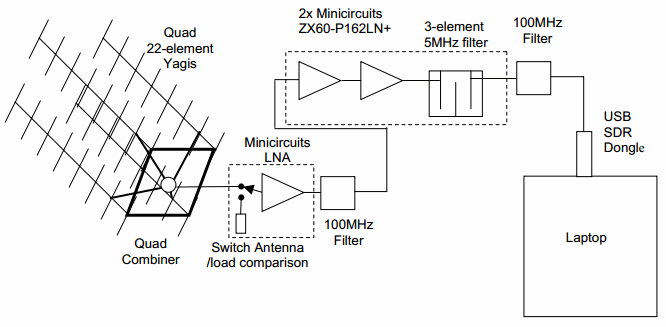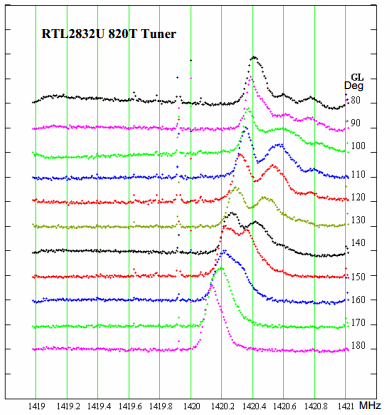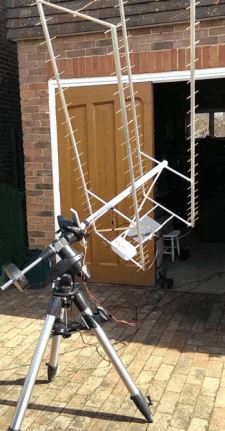Low Cost Hydrogen Line Telescope using the RTL-SDR
Amateur radio astronomer Y1PWE has uploaded a pdf document describing how he created a low cost hydrogen line telescope using an RTL-SDR dongle (links under heading 2. H-Line Receiver) . Hydrogen atoms randomly emit photons at a wavelength of 21cm (1420.4058 MHz). Normally a single hydrogen atom will rarely emit a photon, but since space and the galaxy is filled with many hydrogen atoms the average effect is an observable RF power spike at 1420.4058 MHz. By pointing a radio telescope at the night sky, a power spike indicating the hydrogen line can be observed in a frequency spectrum plot.
Y1PWE created a radio telescope using a quad 22 element yagi antenna, several LNA's and filters and an RTL-SDR dongle and laptop. Using this setup he can capture some raw IQ data from the RTL-SDR and then use an FFT averaging program to produce some plots. In his plots the hydrogen line is clearly visible.

 |
 |
Intriguing! Incidentally I am working on a cooled SDR so I can directly observer the hydrogen line.
It might actually work as many of the earlier R820T’s were better at 1.420 than newer ones for some reason but only when cold.
Also incidentally I am on Twitter as well if anyone wants to say hi, ‘toomanysecrets’
The link to the PDF isn’t working, is there a mirror? Or does someone have the PDF and is able to share it?
Thank you!
I updated the link to go to directly to his website, from there you can download it under the heading 2. H-Line Receiver.
Thank you very much!
BTW, just in case you need to follow the instructions on his site to download it:
“For bona-fide users I have had to modify the pdf document links by adding a space before the .pdf extension.
To download wanted documents successfully, you need to remove the space in your browser window.”
Got it, thanks!
Very nice work you’ve done in building the 4 yagi antenna system for radio astronomy.
Maybe to minimize the combiner issues and improve efficiency, maybe integrate the driven yagi elements with an amplifier and then combine. Your switch addition is good. Since all the Yagi elements are passive but 1, perhaps draw the bottom three on pcb board with the amplifier and connectors integrated. (This may be a difficult suggestion to implement for just one system, but could be great if others wanted to duplicate your setup for schools etc).
You must have put a lot of work into the structure for the 4 yagi elements. It looks very good.
board